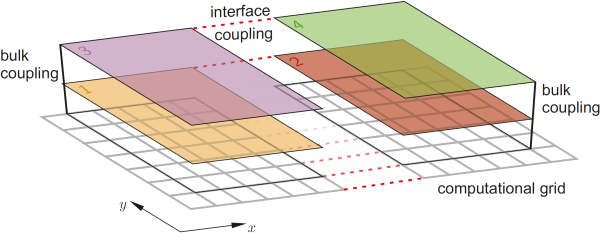Bulk- and Interface-Coupling
Bulk- and Interface-Coupling
The projects of this research unit distinguish between two notions of coupling.

On the one hand, multi-physics systems are meant to consider multiple physical effects or processes in order to describe the evolution. The mathematical equations are built from various blocks, for example, fluid mechanics and electrodynamics. The interaction of these processes happens in any point of the computational domain, for example by exchange of momentum and energy, or through additional fluxes. This bulk-coupling is sometimes also referred to as vertical coupling.
On the other hand, physical models come in different flavors or descriptions, related to the asymptotics of the process, for instance. Examples for this would be static or dynamic Maxwell equations, and fluid or kinetic-fluid description. These different descriptions may use very different mathematical formulations. The peculiarities of a large physical system may require the use of different model formulations in different parts of the simulation. Due to the structure of the mathematical models, these parts of the domain will be coupled, typically through fluxes. This interface-coupling is also known as horizontal coupling.
Realistically, both coupling patterns will occur in a simulation at the same time. Different processes in the bulk may change to different descriptions in the neighboring parts of the computational domain. This situation is shown schematically in the above figure for an exemplary pairing of models. To design numerical methods that handle these coupling phenomena robustly and accurately is one of the main goals of this proposal.
